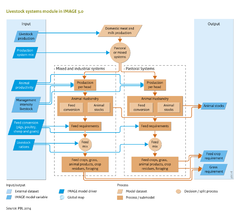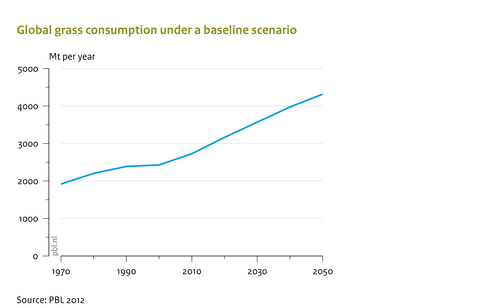Livestock systems/Policy issues
Parts of Livestock systems/Policy issues
| Component is implemented in: |
| Components: |
| Related IMAGE components |
| Projects/Applications |
|
| Models/Databases |
| Key publications |
Baseline developments
Between 1970 and 2010, global grass consumption increased by more than 40% (see figure below), while global grassland area only increased about 5% from 3134 to 3313 million hectares in the same period (see the figure in the policy intervention example section). The global area of pastoral grassland only shows slight and gradual changes. While extensive pastoral production systems have changed little, mixed and industrial systems have moved rapidly towards intensification. Most baseline scenarios indicate that a similar slow increase in grassland area is required over the coming decades as observed historically. Under the baseline scenario from the Rio+20 study, these developments result in a small increase of 2% in global grassland area (see the figure in the policy intervention example section), but this will require considerable productivity increases in many parts of the world as discussed in Bouwman et al., 2005.
Policy interventions
- A larger proportion of livestock production in mixed systems will inherently increase overall feed conversion ratios of ruminants;
- production parameters, such as milk production per animal, carcass weight and off-take rates, will have an effect on the feed conversion ratio, which in general will be lower in more productive animals;
- feed conversion ratio of small ruminants, such as sheep and goats, will reduce demand for grass;
- the proportion of grass in the feed for cattle, and sheep and goats will decrease with the use of feed crops;
- more intensive grazing will require improved grassland management, including use of grass-clover mixes and fertilisers, and aligning the grazing season with grass production and rotations.
All such interventions have been combined in the Global Technology (GT) scenario of the Rio+20 study, resulting in more production in mixed systems (+10%), higher carcass weights (+10%), higher off-take rates (+10%), more efficient feed conversion by sheep and goats (+10%), more feed crops (15%) and higher grazing intensities (15%). This package leads to a considerable reduction in grassland area of about 15% compared to the baseline scenario for 2050 (see figure below), leaving more area for biodiversity recovery.
Effects of policy interventions on this component
| Policy intervention | Description | Effect |
|---|---|---|
| Change in grazing intensity | Change in grazing intensity, usually more intensive. This would require better management of grasslands, including for example the use of grass-clover mixtures and fertilisers, bringing the length of the grazing season in tune with the period of grass production, and rotations. | Increasing grazing intensity has no consequences for the livestock if not combined with introduction of better breeds |
| Changes in consumption and diet preferences | Interventions that target consumption changes or changes in dietary preferences (Reference:: Stehfest et al., 2013) | Changes the production of livestock products within a region. |
| Changes in feed ration (*) | Change in the share of grass in the feed rations of cattle, sheep and goats, usually a decrease, meaning grass will be substituted by feed crops and the livestock system will be more intensive. | changes the grass and feed crop demand for the required livestock production. |
| Improvement of feed conversion (*) | Improvement of feed conversion ratio of small ruminants, such as sheep and goats. This means other breeds will be used that need less grass to produce the same amount of meat. | decreases the demand for grass. |
| Increased livestock productivity (*) | A change in production characteristics, such as milk production per animal, carcass weight and off-take rates, which will also have an impact on the feed conversion ratio; in general, this will be lower in more productive animals | Change the amount of feed crops and grass needed to feed animals. |

